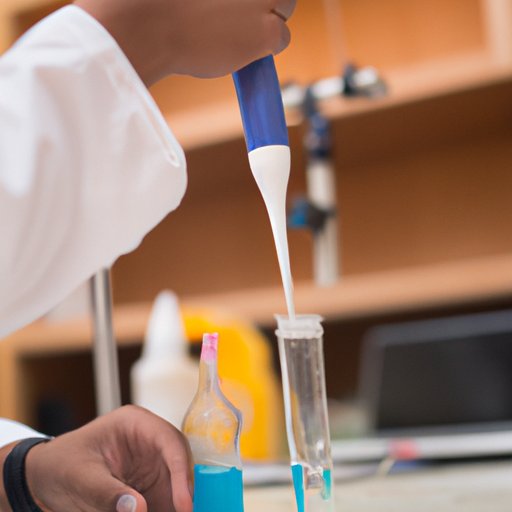I. Introduction
Chemistry deals with the composition, properties, and reactions of matter. One of the fundamental concepts that underpins chemistry is concentration. In this article, we will explore what concentration means, why it is important in chemistry, and how it can be calculated.
Whether you’re a student, a researcher, or simply someone interested in chemistry, understanding concentration is essential. The better you understand concentration, the better you will be able to monitor, control, and manipulate chemical reactions.
II. Overview of Concentration in Chemistry: Explanation and Definitions
Concentration refers to the amount of a substance that is present in a given volume or amount of another substance. In chemistry, it is used to describe the amount of solute dissolved in a certain amount of solvent.
The concentration of a solution is important because it affects the properties of the solution as well as any chemical reactions that occur in the solution. For example, the rate at which a chemical reaction occurs can vary depending on the concentration of the reactants. Additionally, the physical properties of a solution, such as its boiling and freezing points, are also affected by its concentration.
There are different ways to measure concentration, and the choice of method depends on the particular problem you are trying to solve. Some common methods include:
- Molarity
- Molality
- Mass percent
- Volume percent
- Parts per thousand (ppt)
- Parts per million (ppm)
- Parts per billion (ppb)
III. A Guide on How to Calculate Concentration in Chemistry
Accurate measurement is crucial when calculating concentration. Inaccurate measurement can lead to incorrect results and can be dangerous in some cases. Before calculating concentration, you need to know the amount of solute and the amount of solvent in the solution. The amount of solute is usually given in grams, and the amount of solvent is given in milliliters or liters.
There are several ways to calculate concentration, depending on the method used to express concentration. Here are some common methods:
- Molarity: The number of moles of solute per liter of solution.
- Molality: The number of moles of solute per kilogram of solvent.
- Mass percent: The mass of solute divided by the mass of the solution, multiplied by 100%.
- Volume percent: The volume of solute divided by the volume of the solution, multiplied by 100%.
Calculating concentration can seem daunting, but it is a straightforward process. Here is a step-by-step guide:
- Determine the amount of solute in grams.
- Determine the amount of solvent in milliliters or liters.
- Convert the amounts to the appropriate units (if necessary).
- Calculate the concentration using the appropriate formula.
IV. Understanding the Importance of Concentration in Chemical Reactions
Concentration affects the rate at which chemical reactions occur. Generally, as the concentration of reactants increases, the rate of the reaction increases as well. This is because a higher concentration of reactants means that there are more collisions between particles, which increases the probability of successful collisions.
Aside from concentration, there are several factors that can affect reaction rates. These include:
- Temperature
- Pressure
- The presence of a catalyst
- The nature of the reactants
- The surface area of the reactants
Real-world examples of the importance of concentration in chemical reactions include the production of ammonia from nitrogen and hydrogen, and the reaction of baking soda and vinegar to produce carbon dioxide.
V. Different Methods of Expressing Concentration in Chemistry
There are different ways to express concentration in chemistry, and each method has its advantages and disadvantages. Here are some of the most common methods:
- Percentage: This method expresses concentration as a percentage by mass or volume.
- Molarity: This method expresses concentration as the number of moles of solute per liter of solution.
- Molality: This method expresses concentration as the number of moles of solute per kilogram of solvent.
The choice of method depends on the particular problem you are trying to solve. For example, if you are interested in a chemical reaction that occurs in a particular volume of solution, molarity may be the most appropriate measure of concentration. If you are interested in the physical properties of a solution, such as its freezing point, molality may be more appropriate.
VI. Applications of Concentration in Chemistry: Real-World Examples
Concentration has a wide range of applications in chemistry, from the production of pharmaceuticals to the creation of food products. Here are some real-world examples:
- Pharmaceuticals: The concentration of active ingredients in medications is carefully controlled to ensure their efficacy and safety.
- Food: The concentration of salt, sugar, and other ingredients in food products affects their taste, texture, and preservation.
- Chemical processes: The concentration of reactants and products is carefully monitored and controlled in industrial processes to optimize efficiency and safety.
Accurate measurement and control of concentration is essential in these and many other industries in order to ensure quality and safety.
VII. Conclusion
Understanding concentration is essential in chemistry. It is important in monitoring, controlling, and manipulating chemical reactions, as well as in a wide range of industries such as pharmaceuticals and food production. By understanding the different methods of expressing concentration, calculating concentration accurately, and grasping the importance of concentration in chemical reactions, readers can gain a deeper understanding of chemistry and its applications.
